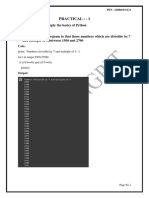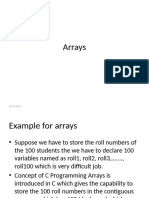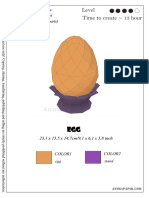16 ArraysinPython-JupyterNotebook
Uploaded by
Anjali16 ArraysinPython-JupyterNotebook
Uploaded by
Anjali13.06.2022 13:12 16.
Arrays in Python - Jupyter Notebook
Python Tutorial
Created by Mustafa Germec, PhD
16. Arrays in Python
Array is a container which can hold a fix number of items and these items should be of the same type.
Most of the data structures make use of arrays to implement their algorithms.
Lists can be used to form arrays.
Following are the important terms to understand the concept of Array.
Element: Each item stored in an array is called an element.
Index: Each location of an element in an array has a numerical index, which is used to identify the
element.
Array index begins with 0.
Each element in the array can be accessed with its index number.
The length of the array describes the capacity to store the elements.
Basic array operations are Traverse, Insertion, Deletion, Search, and Update.
Creating an array
You should import the module name 'array' as follows:
import array or from array import (*).
(*) means that it covers all features of the array.
localhost:8888/notebooks/Desktop/PROGRAMMING/PYTHON_TUTORIAL/01. python_files_for_sharing/jupyter_notebook_files/16. Arrays in Py… 1/10
13.06.2022 13:12 16. Arrays in Python - Jupyter Notebook
In [4]:
1 # Import the module
2 import array as arr
3 from array import *
In [5]:
1 # To access more information regarding array, you can execute the following commands
2 help(arr)
Help on built-in module array:
NAME
array
DESCRIPTION
This module defines an object type which can efficiently represent
an array of basic values: characters, integers, floating point
numbers. Arrays are sequence types and behave very much like lists,
except that the type of objects stored in them is constrained.
CLASSES
builtins.object
array
ArrayType = class array(builtins.object)
| array(typecode [, initializer]) -> array
|
| Return a new array whose items are restricted by typecode, and
| initialized from the optional initializer value which must be a list
Type code
Arrays represent basic values and behave very much like lists, except the type of objects stored in them is
constrained.
The type is specified at object creation time by using a type code, which is a single character.
The following type codes are defined:
localhost:8888/notebooks/Desktop/PROGRAMMING/PYTHON_TUTORIAL/01. python_files_for_sharing/jupyter_notebook_files/16. Arrays in Py… 2/10
13.06.2022 13:12 16. Arrays in Python - Jupyter Notebook
In [6]:
1 special_nums = arr.array('d', [0.577, 1.618, 2.718, 3.14, 6, 37, 1729])
2 for i in special_nums:
3 print(i)
0.577
1.618
2.718
3.14
6.0
37.0
1729.0
Accessing
In [7]:
1 special_nums = arr.array('d', [0.577, 1.618, 2.718, 3.14, 6, 37, 1729])
2 print(f'First element of numbers is {special_nums[0]}, called euler constant.')
3 print(f'Second element of numbers is {special_nums[1]}, called golden_ratio.')
4 print(f'Last element of numbers is {special_nums[-1]}, called Ramanujan-Hardy number.')
First element of numbers is 0.577, called euler constant.
Second element of numbers is 1.618, called golden_ratio.
Last element of numbers is 1729.0, called Ramanujan-Hardy number.
Changing or Updating
localhost:8888/notebooks/Desktop/PROGRAMMING/PYTHON_TUTORIAL/01. python_files_for_sharing/jupyter_notebook_files/16. Arrays in Py… 3/10
13.06.2022 13:12 16. Arrays in Python - Jupyter Notebook
In [8]:
1 nums = arr.array('i', [0, 1, 1, 2, 3, 5, 8, 13, 21, 34])
2
3 # Changing the first element of the array
4 nums[0] = 55
5 print(nums)
6
7 # Changing 2nd to 4th elements of the array
8 nums[1:4] =arr.array('i', [89, 144, 233, 377])
9 print(nums)
array('i', [55, 1, 1, 2, 3, 5, 8, 13, 21, 34])
array('i', [55, 89, 144, 233, 377, 3, 5, 8, 13, 21, 34])
Deleting
In [9]:
1 nums = arr.array('i', [0, 1, 1, 2, 3, 5, 8, 13, 21, 34])
2
3 # Deleting the first element of the array
4 del nums[0]
5 print(nums)
6
7 # Deleting the 2nd to 4th elements of the array
8 del nums[1:4]
9 print(nums)
array('i', [1, 1, 2, 3, 5, 8, 13, 21, 34])
array('i', [1, 5, 8, 13, 21, 34])
Lenght of the array
In [10]:
1 special_nums = arr.array('d', [0.577, 1.618, 2.718, 3.14, 6, 37, 1729])
2 print(f'The length of the array is {len(special_nums)}.')
The length of the array is 7.
Concatenation
In [11]:
1 special_nums = arr.array('d', [0.577, 1.618, 2.718, 3.14, 6, 37, 1729])
2 fibonacci_nums = arr.array('d', [1, 1, 2, 3, 5, 8, 13, 21, 34])
3 special_fibonacci_nums = arr.array('d')
4 special_fibonacci_nums = special_nums + fibonacci_nums
5 print(f'The new array called special_fibonacci_nums is {special_fibonacci_nums}.')
The new array called special_fibonacci_nums is array('d', [0.577, 1.618, 2.718, 3.14, 6.0, 37.0, 1729.0, 1.
0, 1.0, 2.0, 3.0, 5.0, 8.0, 13.0, 21.0, 34.0]).
localhost:8888/notebooks/Desktop/PROGRAMMING/PYTHON_TUTORIAL/01. python_files_for_sharing/jupyter_notebook_files/16. Arrays in Py… 4/10
13.06.2022 13:12 16. Arrays in Python - Jupyter Notebook
Creating ID arrays
In [12]:
1 mult = 10
2 one_array = [1]*mult
3 print(one_array)
[1, 1, 1, 1, 1, 1, 1, 1, 1, 1]
In [13]:
1 mult = 10
2 nums_array = [i for i in range(mult)]
3 print(nums_array)
[0, 1, 2, 3, 4, 5, 6, 7, 8, 9]
Addition with the functions insert() and append()
In [14]:
1 # Using the function 'insert()'
2 fibonacci_nums = arr.array('i', [1, 1, 2, 3, 5, 8, 13, 21, 34])
3 print('Before any additon into fibonacci numbers')
4 for i in fibonacci_nums:
5 print(i, end = ' ')
6 print()
7 print('After an element additon into fibonacci numbers')
8 added_num = fibonacci_nums[-1] + fibonacci_nums[-2]
9 fibonacci_nums.insert(9, added_num)
10 for i in fibonacci_nums:
11 print(i, end = ' ')
12 print()
13 print('After an element additon into fibonacci numbers')
14 added_num = fibonacci_nums[-1] + fibonacci_nums[-2]
15 fibonacci_nums.insert(10, added_num)
16 for i in fibonacci_nums:
17 print(i, end = ' ')
Before any additon into fibonacci numbers
1 1 2 3 5 8 13 21 34
After an element additon into fibonacci numbers
1 1 2 3 5 8 13 21 34 55
After an element additon into fibonacci numbers
1 1 2 3 5 8 13 21 34 55 89
localhost:8888/notebooks/Desktop/PROGRAMMING/PYTHON_TUTORIAL/01. python_files_for_sharing/jupyter_notebook_files/16. Arrays in Py… 5/10
13.06.2022 13:12 16. Arrays in Python - Jupyter Notebook
In [15]:
1 # Using the function 'append()'
2 fibonacci_nums = arr.array('i', [1, 1, 2, 3, 5, 8, 13, 21, 34])
3 print('Before any additon into fibonacci numbers')
4 for i in fibonacci_nums:
5 print(i, end = ' ')
6 print()
7 print('After an element additon into fibonacci numbers')
8 added_num = fibonacci_nums[-1] + fibonacci_nums[-2]
9 fibonacci_nums.append(added_num)
10 for i in fibonacci_nums:
11 print(i, end = ' ')
12 print()
13 print('After an element additon into fibonacci numbers')
14 added_num = fibonacci_nums[-1] + fibonacci_nums[-2]
15 fibonacci_nums.append(added_num)
16 for i in fibonacci_nums:
17 print(i, end = ' ')
Before any additon into fibonacci numbers
1 1 2 3 5 8 13 21 34
After an element additon into fibonacci numbers
1 1 2 3 5 8 13 21 34 55
After an element additon into fibonacci numbers
1 1 2 3 5 8 13 21 34 55 89
Removing with the function remove() and pop()
In [16]:
1 # Using the function 'remove()'
2 special_nums = arr.array('d', [0.577, 1.618, 2.718, 3.14, 6, 37, 1729])
3 print('Before removing an element from the array')
4 for i in special_nums:
5 print(i, end = ' ')
6 print()
7 print('After removing an element from the array')
8 special_nums.remove(0.577)
9 for i in special_nums:
10 print(i, end=' ')
11 print()
12 print('After removing one more element from the array')
13 special_nums.remove(special_nums[0]) # We can make this using indexing
14 for i in special_nums:
15 print(i, end=' ')
Before removing an element from the array
0.577 1.618 2.718 3.14 6.0 37.0 1729.0
After removing an element from the array
1.618 2.718 3.14 6.0 37.0 1729.0
After removing one more element from the array
2.718 3.14 6.0 37.0 1729.0
localhost:8888/notebooks/Desktop/PROGRAMMING/PYTHON_TUTORIAL/01. python_files_for_sharing/jupyter_notebook_files/16. Arrays in Py… 6/10
13.06.2022 13:12 16. Arrays in Python - Jupyter Notebook
In [17]:
1 # Using the function 'pop()'
2 # The function pop() removes the last element from the array
3 special_nums = arr.array('d', [0.577, 1.618, 2.718, 3.14, 6, 37, 1729])
4 print('Before removing an element from the array')
5 for i in special_nums:
6 print(i, end = ' ')
7 print()
8 print('After removing last element from the array')
9 special_nums.pop()
10 for i in special_nums:
11 print(i, end=' ')
12 print()
13 print('After removing one more last element from the array')
14 special_nums.pop()
15 for i in special_nums:
16 print(i, end=' ')
17 print()
18 print('After removing one more element using index from the array')
19 special_nums.pop(3) # It deleted the pi number
20 for i in special_nums:
21 print(i, end=' ')
22 print()
Before removing an element from the array
0.577 1.618 2.718 3.14 6.0 37.0 1729.0
After removing last element from the array
0.577 1.618 2.718 3.14 6.0 37.0
After removing one more last element from the array
0.577 1.618 2.718 3.14 6.0
After removing one more element using index from the array
0.577 1.618 2.718 6.0
Slicing
In [18]:
1 special_nums = arr.array('d', [0.577, 1.618, 2.718, 3.14, 6, 37, 1729])
2 sliced_special_nums = special_nums[1:5] # It returns between index 1 and index 4, not index 5.
3 print(sliced_special_nums)
4 # or using for loop
5 for i in sliced_special_nums:
6 print(i, end = " ")
array('d', [1.618, 2.718, 3.14, 6.0])
1.618 2.718 3.14 6.0
In [19]:
1 special_nums = arr.array('d', [0.577, 1.618, 2.718, 3.14, 6, 37, 1729])
2 sliced_special_nums = special_nums[3:] # It returns index 3 and later.
3 print(sliced_special_nums)
array('d', [3.14, 6.0, 37.0, 1729.0])
localhost:8888/notebooks/Desktop/PROGRAMMING/PYTHON_TUTORIAL/01. python_files_for_sharing/jupyter_notebook_files/16. Arrays in Py… 7/10
13.06.2022 13:12 16. Arrays in Python - Jupyter Notebook
In [20]:
1 special_nums = arr.array('d', [0.577, 1.618, 2.718, 3.14, 6, 37, 1729])
2 sliced_special_nums = special_nums[:3] # It returns until index 2, not index 3.
3 print(sliced_special_nums)
array('d', [0.577, 1.618, 2.718])
In [21]:
1 special_nums = arr.array('d', [0.577, 1.618, 2.718, 3.14, 6, 37, 1729])
2 sliced_special_nums = special_nums[:] # It returns all elements in the array
3 print(sliced_special_nums)
array('d', [0.577, 1.618, 2.718, 3.14, 6.0, 37.0, 1729.0])
In [22]:
1 special_nums = arr.array('d', [0.577, 1.618, 2.718, 3.14, 6, 37, 1729])
2 sliced_special_nums = special_nums[::-1] # It reverses the array.
3 print(sliced_special_nums)
array('d', [1729.0, 37.0, 6.0, 3.14, 2.718, 1.618, 0.577])
Searching
In [23]:
1 # To make a search in an array, use the function index()
2 special_nums = arr.array('d', [0.577, 1.618, 2.718, 3.14, 6, 37, 1729])
3 searched_item = special_nums.index(2.718)
4 print(f'The searched item euler number 2.718 is present at index {searched_item}.')
5 # printing with format
6 print('The searched item euler number {} is present at index {}.'.format(2.718, searched_item))
The searched item euler number 2.718 is present at index 2.
The searched item euler number 2.718 is present at index 2.
Copying
Copying using assignment
This process gives the same ID number.
localhost:8888/notebooks/Desktop/PROGRAMMING/PYTHON_TUTORIAL/01. python_files_for_sharing/jupyter_notebook_files/16. Arrays in Py… 8/10
13.06.2022 13:12 16. Arrays in Python - Jupyter Notebook
In [24]:
1 special_nums = arr.array('d', [0.577, 1.618, 2.718, 3.14, 6, 37, 1729])
2 copied_special_nums = special_nums
3 print(special_nums, 'with the ID number', id(special_nums))
4 print(copied_special_nums, 'with the ID number', id(copied_special_nums))
5
6 # Using for loop
7 for i in special_nums:
8 print(i, end= ' ')
9 print()
10 print(f'The ID number of the array special_nums is {id(special_nums)}.')
11 for i in copied_special_nums:
12 print(i, end= ' ')
13 print()
14 print(f'The ID number of the array copied_special_nums is {id(copied_special_nums)}.')
array('d', [0.577, 1.618, 2.718, 3.14, 6.0, 37.0, 1729.0]) with the ID number 2668250199472
array('d', [0.577, 1.618, 2.718, 3.14, 6.0, 37.0, 1729.0]) with the ID number 2668250199472
0.577 1.618 2.718 3.14 6.0 37.0 1729.0
The ID number of the array special_nums is 2668250199472.
0.577 1.618 2.718 3.14 6.0 37.0 1729.0
The ID number of the array copied_special_nums is 2668250199472.
Copying using view()
This process gives the different ID number.
In [25]:
1 # import numpy library
2 import numpy as np
3
4 # Copying the array
5 special_nums = np.array( [0.577, 1.618, 2.718, 3.14, 6, 37, 1729])
6 copied_special_nums = special_nums.view()
7 print(special_nums, 'with the ID number', id(special_nums))
8 print(copied_special_nums, 'with the ID number', id(copied_special_nums))
9
10 #Using for loop
11 for i in special_nums:
12 print(i, end = ' ')
13 print()
14 for i in copied_special_nums:
15 print(i, end = ' ')
16
[5.770e-01 1.618e+00 2.718e+00 3.140e+00 6.000e+00 3.700e+01 1.729e+03] with the ID number 2668
248532144
[5.770e-01 1.618e+00 2.718e+00 3.140e+00 6.000e+00 3.700e+01 1.729e+03] with the ID number 2668
254732400
0.577 1.618 2.718 3.14 6.0 37.0 1729.0
0.577 1.618 2.718 3.14 6.0 37.0 1729.0
Copying using copy()
This process gives the different ID number.
localhost:8888/notebooks/Desktop/PROGRAMMING/PYTHON_TUTORIAL/01. python_files_for_sharing/jupyter_notebook_files/16. Arrays in Py… 9/10
13.06.2022 13:12 16. Arrays in Python - Jupyter Notebook
In [26]:
1 # import numpy library
2 import numpy as np
3
4 # Copying the array
5 special_nums = np.array( [0.577, 1.618, 2.718, 3.14, 6, 37, 1729])
6 copied_special_nums = special_nums.copy()
7 print(special_nums, 'with the ID number', id(special_nums))
8 print(copied_special_nums, 'with the ID number', id(copied_special_nums))
9
10 #Using for loop
11 for i in special_nums:
12 print(i, end = ' ')
13 print()
14 for i in copied_special_nums:
15 print(i, end = ' ')
16
[5.770e-01 1.618e+00 2.718e+00 3.140e+00 6.000e+00 3.700e+01 1.729e+03] with the ID number 2668
254735376
[5.770e-01 1.618e+00 2.718e+00 3.140e+00 6.000e+00 3.700e+01 1.729e+03] with the ID number 2668
254736144
0.577 1.618 2.718 3.14 6.0 37.0 1729.0
0.577 1.618 2.718 3.14 6.0 37.0 1729.0
localhost:8888/notebooks/Desktop/PROGRAMMING/PYTHON_TUTORIAL/01. python_files_for_sharing/jupyter_notebook_files/16. Arrays in P… 10/10
You might also like
- Arrays in C: Int Grade0 Int Grade1 Int Grade2 Int Grade3 Int Grade4No ratings yetArrays in C: Int Grade0 Int Grade1 Int Grade2 Int Grade3 Int Grade48 pages
- Dynamic Array, Pointers, Etc C++ Programming.No ratings yetDynamic Array, Pointers, Etc C++ Programming.22 pages
- Apznzabrhwleihg81eirvirzpf-5y7m5ynf73ynoqedmsjf4 Nfvlifwhcoccdwddxqyigmuqotvl8mysxuzqzsfogijh2l Bx 3rssopzd5in4yxdtb0gbvbrxuuypbyz5lw36d Fp3bqti7zm5nhwmwqi4iffc5cg6iaz1yh7p07sxbnzmxvh2taiznvpkifnw60ib856awstbjbwh6yNo ratings yetApznzabrhwleihg81eirvirzpf-5y7m5ynf73ynoqedmsjf4 Nfvlifwhcoccdwddxqyigmuqotvl8mysxuzqzsfogijh2l Bx 3rssopzd5in4yxdtb0gbvbrxuuypbyz5lw36d Fp3bqti7zm5nhwmwqi4iffc5cg6iaz1yh7p07sxbnzmxvh2taiznvpkifnw60ib856awstbjbwh6y60 pages
- Class Notes Class: XII Date: 17-04-2021 Subject: Informatics Practices Topic: Chapter-1No ratings yetClass Notes Class: XII Date: 17-04-2021 Subject: Informatics Practices Topic: Chapter-15 pages
- Unit III - Data Manipulation Using PythonNo ratings yetUnit III - Data Manipulation Using Python16 pages
- Introduction To Numpy Pandas and MatplotlibNo ratings yetIntroduction To Numpy Pandas and Matplotlib2 pages
- Python Functions and Array - List - Set - Tuples ProgramsNo ratings yetPython Functions and Array - List - Set - Tuples Programs59 pages
- Python Numpy Programming: Eliot FeibushNo ratings yetPython Numpy Programming: Eliot Feibush66 pages
- Unit - 1 1.what Are The Features of Python. Explain The PVM. Ans: Following Are Some Important Features of PythonNo ratings yetUnit - 1 1.what Are The Features of Python. Explain The PVM. Ans: Following Are Some Important Features of Python15 pages
- Fundamentals of Programming - Lecture 10No ratings yetFundamentals of Programming - Lecture 1026 pages
- Metal Forming Lecture 3 Stress Strain AnalysesNo ratings yetMetal Forming Lecture 3 Stress Strain Analyses30 pages
- Consumer Culture A Reference Handbook Douglas Goodman - The latest ebook is available for instant download now100% (1)Consumer Culture A Reference Handbook Douglas Goodman - The latest ebook is available for instant download now57 pages
- Neumann Rhodes 2023 Morality in Social Media A Scoping ReviewNo ratings yetNeumann Rhodes 2023 Morality in Social Media A Scoping Review31 pages
- Algebra1Unit1Lesson4 - Notes - Multiplying PolynomialsNo ratings yetAlgebra1Unit1Lesson4 - Notes - Multiplying Polynomials8 pages
- Symbolic Violence As A Form of Violence Against WoNo ratings yetSymbolic Violence As A Form of Violence Against Wo12 pages
- Purchasing Organization in Enterprise: Supply Chain Management100% (1)Purchasing Organization in Enterprise: Supply Chain Management57 pages
- Waste Water Treatment 2023 Mid Sem Question PaperNo ratings yetWaste Water Treatment 2023 Mid Sem Question Paper4 pages
- Arrays in C: Int Grade0 Int Grade1 Int Grade2 Int Grade3 Int Grade4Arrays in C: Int Grade0 Int Grade1 Int Grade2 Int Grade3 Int Grade4
- Apznzabrhwleihg81eirvirzpf-5y7m5ynf73ynoqedmsjf4 Nfvlifwhcoccdwddxqyigmuqotvl8mysxuzqzsfogijh2l Bx 3rssopzd5in4yxdtb0gbvbrxuuypbyz5lw36d Fp3bqti7zm5nhwmwqi4iffc5cg6iaz1yh7p07sxbnzmxvh2taiznvpkifnw60ib856awstbjbwh6yApznzabrhwleihg81eirvirzpf-5y7m5ynf73ynoqedmsjf4 Nfvlifwhcoccdwddxqyigmuqotvl8mysxuzqzsfogijh2l Bx 3rssopzd5in4yxdtb0gbvbrxuuypbyz5lw36d Fp3bqti7zm5nhwmwqi4iffc5cg6iaz1yh7p07sxbnzmxvh2taiznvpkifnw60ib856awstbjbwh6y
- Class Notes Class: XII Date: 17-04-2021 Subject: Informatics Practices Topic: Chapter-1Class Notes Class: XII Date: 17-04-2021 Subject: Informatics Practices Topic: Chapter-1
- Python Functions and Array - List - Set - Tuples ProgramsPython Functions and Array - List - Set - Tuples Programs
- Unit - 1 1.what Are The Features of Python. Explain The PVM. Ans: Following Are Some Important Features of PythonUnit - 1 1.what Are The Features of Python. Explain The PVM. Ans: Following Are Some Important Features of Python
- Advanced C Concepts and Programming: First EditionFrom EverandAdvanced C Concepts and Programming: First Edition
- Consumer Culture A Reference Handbook Douglas Goodman - The latest ebook is available for instant download nowConsumer Culture A Reference Handbook Douglas Goodman - The latest ebook is available for instant download now
- Neumann Rhodes 2023 Morality in Social Media A Scoping ReviewNeumann Rhodes 2023 Morality in Social Media A Scoping Review
- Algebra1Unit1Lesson4 - Notes - Multiplying PolynomialsAlgebra1Unit1Lesson4 - Notes - Multiplying Polynomials
- Symbolic Violence As A Form of Violence Against WoSymbolic Violence As A Form of Violence Against Wo
- Purchasing Organization in Enterprise: Supply Chain ManagementPurchasing Organization in Enterprise: Supply Chain Management

























































































